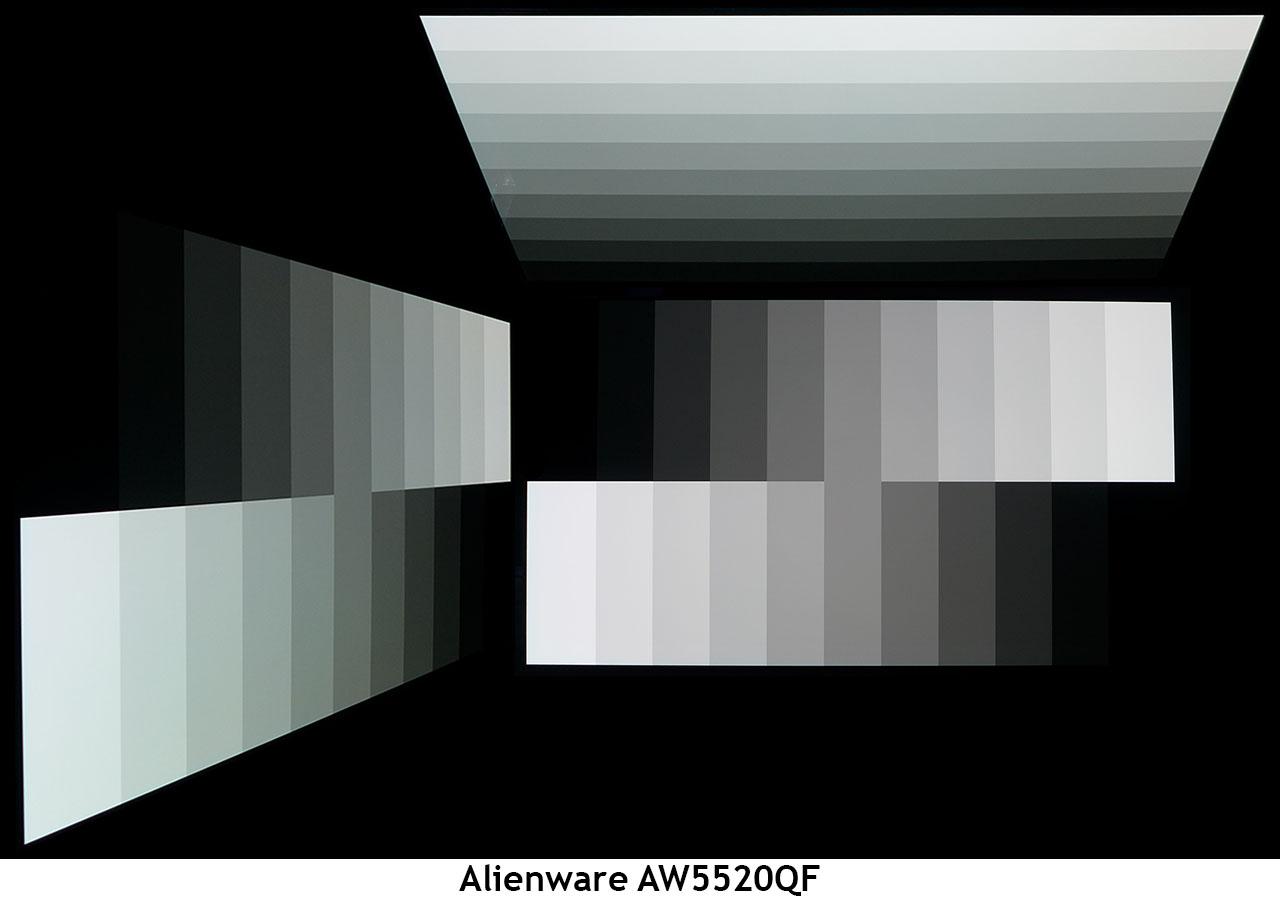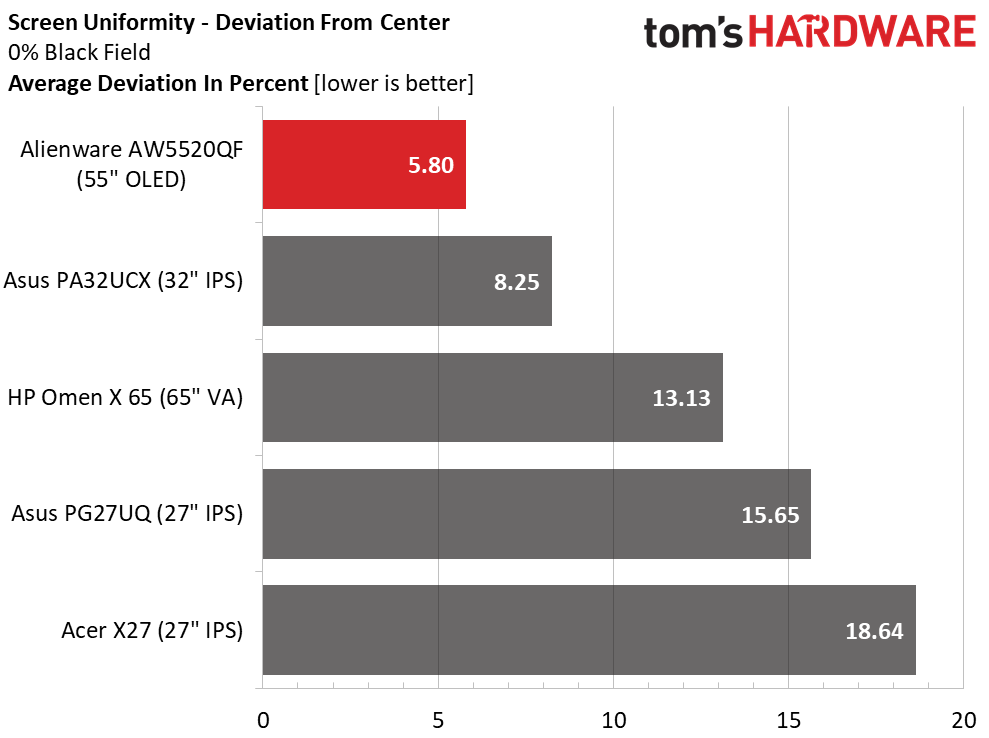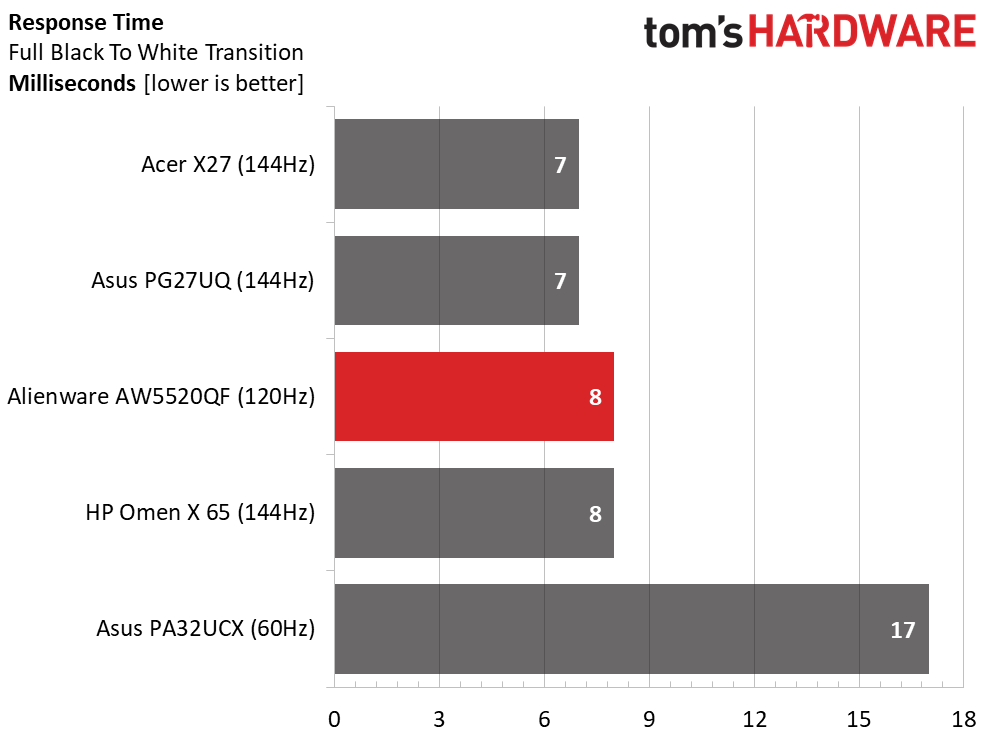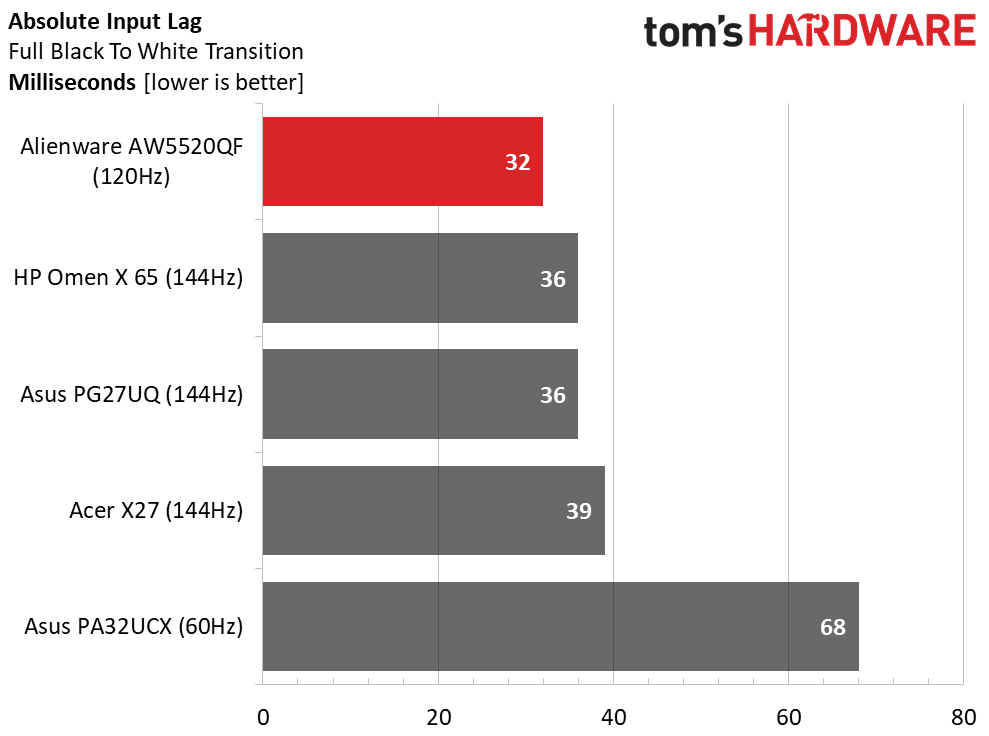Why you can trust Tom's Hardware
Viewing Angles

The common belief about OLEDs is that they have perfect viewing angles with no light falloff or color shift to the sides. The AW5520QF doesn’t meet that expectation. While brightness is reduced only by a small amount, when viewing from the sides, there is a visible green shift. Why? Because it uses a grid polarizer. Its effect isn’t as significant as the one installed in an LCD, but it is there nonetheless. While these photos are far better than any LCD can boast, OLED is not perfect when it comes to off-axis viewing.
Screen Uniformity
To learn how we measure screen uniformity, click here.

Since the AW5520QF has an immeasurable black level, we had to use a 10% field pattern, which is very dark gray, not completely black, for this test. Obviously, there are no issues here. The AW5520QF is one of the best screens we’ve ever tested in this regard. There are no visible issues anywhere on the panel. And the gray patterns look perfect at every brightness level.
Pixel Response and Input Lag
Click here to read up on our pixel response and input lag testing procedures.


If you’re paying $4,000 for a gaming monitor, it needs to perform at high speed. Though the AW5520QF’s refresh rate is just 120Hz, it has no trouble keeping up with the 144Hz competition. It should be noted that an 8ms screen draw doesn’t mean the X27 and PG27UQ have lower motion blur. Since OLEDs flash the image at a rate of around 2,000Hz, there is no part of the image that remains on the screen between refresh cycles. LCDs use the sample-and-hold method, meaning they’re never black unless a backlight strobe is used. The bottom line is you will never see motion blur on an OLED unless its specifically rendered by the content.
In our input lag test, the AW5520QF beat all the LCDs here with an impressive 32ms of total control latency. While a 240Hz screen will be quicker, 32ms is more than quick enough for all but the most competitive players.
MORE: Best Gaming Monitors
Get Tom's Hardware's best news and in-depth reviews, straight to your inbox.
MORE: How We Test Monitors
MORE: All Monitor Content
Current page: Viewing Angles, Uniformity, Response and Lag
Prev Page HDR Performance Next Page Conclusion
Christian Eberle is a Contributing Editor for Tom's Hardware US. He's a veteran reviewer of A/V equipment, specializing in monitors. Christian began his obsession with tech when he built his first PC in 1991, a 286 running DOS 3.0 at a blazing 12MHz. In 2006, he undertook training from the Imaging Science Foundation in video calibration and testing and thus started a passion for precise imaging that persists to this day. He is also a professional musician with a degree from the New England Conservatory as a classical bassoonist which he used to good effect as a performer with the West Point Army Band from 1987 to 2013. He enjoys watching movies and listening to high-end audio in his custom-built home theater and can be seen riding trails near his home on a race-ready ICE VTX recumbent trike. Christian enjoys the endless summer in Florida where he lives with his wife and Chihuahua and plays with orchestras around the state.
-
nitrium Is this a "monitor"? It's more like 55" TV that has Freesync. "Monitor" is the wrong word imo - "Gaming TV" is more accurate. Also OLED has terrible burn-in, so it can't be used as a regular monitor for extended periods without damaging it with ghosting. I guess if you use it solely for gaming and TV? Oh right, it's a "gaming TV".Reply -
AlistairAB As I read this, I am using my gsync compatible LG OLED TV that I bought for $1360 USD from Bestbuy. Same 120hz at 1440p, and supposedly at 4k coming next year. So the Alienware is completely pointless at its price point.Reply -
mac_angel yea, pretty much as others say, I'd be curious to see how this measures up with LG OLED, as well as the Samsung 8000 Series and up. Samsung was first with VRR (Freesync). Pay that kind of premium over these other TVs does not seem worth it by far, but I also haven't found any proper reviews directed at gaming, or specifically PC gaming. After the past few weeks of researching, I am hoping to pick up three Samsung 55" RU8000 TVs for my computer.Reply
FYI to anyone reading. If you have a good smart phone, there are pretty decent TV calibration apps you can get for your smart phone that use the camera. As good as professional equipment? No. Better than doing it by sight? Big Yes. Especially for the money. -
tharkis842 Use my C8 for gaming/pc all the time, no burn in issues. But no-one wants to hear that. This "monitor" really makes no sense though.Reply -
jacoro1 Reply
The potential for burn in on these sets has been exaggerated. I and many others have been using OLED as a primary PC monitor for extended periods for years without any burn in issues. I even disabled the static brightness limiter in the service menu on my C9, which is meant to help prevent image retention but can be irritating for PC use. Image retention on these sets is generally rare and temporary, with a few exceptions. The LG sets have automatic maintenance routines that run on a schedule to level out wear, and I suspect this Alienware display does as well. Just do common sense things like not running it in torch mode 24/7 on a static image, and maybe have a screen saver turn on after a period of inactivity.nitrium said:Is this a "monitor"? It's more like 55" TV that has Freesync. "Monitor" is the wrong word imo - "Gaming TV" is more accurate. Also OLED has terrible burn-in, so it can't be used as a regular monitor for extended periods without damaging it with ghosting. I guess if you use it solely for gaming and TV? Oh right, it's a "gaming TV".
The price on this Alienware is a bit much though. The C9 has gsync support now and can use it in HDR with double the brightness for $1400